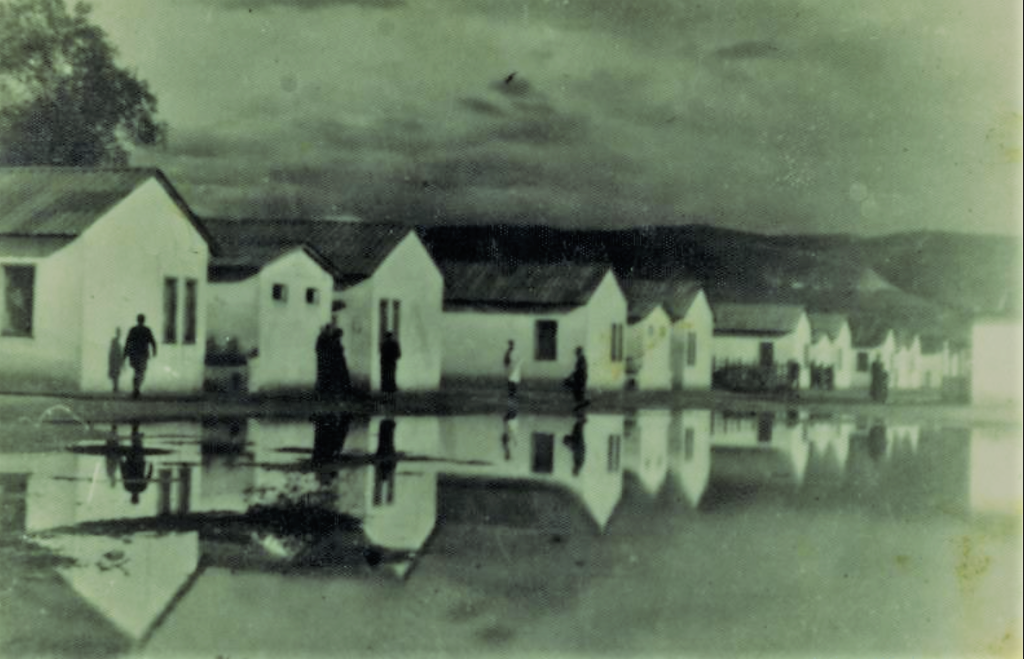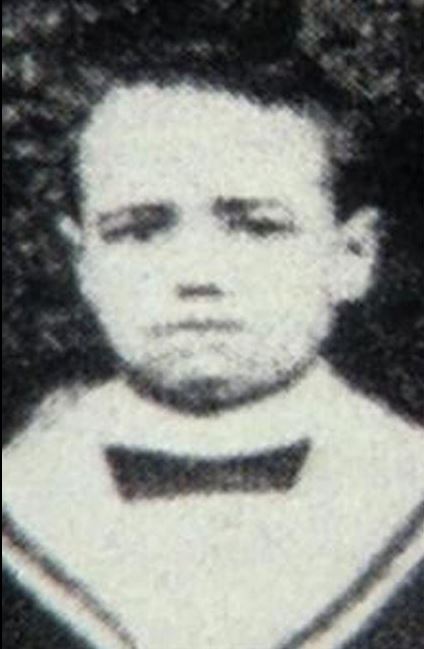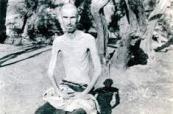
It is a popular misconception that the concentration camps were a Nazi invention, but in fact the British had already established concentration camps in South Africa during the 2nd Boer war.

It could be argued that the Indian reservations in the US were also concentration camps.
But of course the sort of camps which were established just before and during WWII were of a complete different level,than the South African camps and Native American reservations.
It seems that history has also forgotten about the concentration camps built by the Fascist regime of Italy. Although Il Duce, Mussolini is often seen as a farcical figure, he was nevertheless a very evil man following a very disturbed philosophy.

Italy is often portrayed as having been a somewhat benign fascist power during World War II, a reluctant partner of the Nazi regime. The wartime Italian Army is remembered as hapless and inefficient compared to the ruthlessly brutal German war machine
One of the camps established by the Italians was the Rab Concentration camp.
The Rab concentration camp was one of the several Italian concentration camps and was established during World War II, in July 1942, on the Italian-occupied island of Rab (now in Croatia). According to historians James Walston and Carlo Spartaco Capogeco,at 18%, the annual mortality rate in the camp was higher than the average mortality rate in the Nazi concentration camp of Buchenwald (15%). According to a report by Monsignor Jože Srebrnič, Bishop of Krk (Veglia) on 5 August 1943 to Pope Pius XII:

“witnesses, who took part in the burials, state unequivocally that the number of the dead totals at least 3500”.
In September 1943, after the armistice with Italy, the camp was closed, but some of remaining Jewish internees were deported by German forces to the extermination camp at Auschwitz.Yugoslavia, Greece and Ethiopia requested extradition of some 1,200 Italian war criminals, who, however, were never brought before an appropriate tribunal as the British government, at the beginning of the Cold War, saw in Pietro Badoglio a guarantor of an anti-communist post-war Italy.

Under the Italian army commander Mario Roatta’s watch the ethnic cleansing and the violence against the Slovene civil population easily matched the German with the summary executions, hostage-taking and hostage killing, reprisals, internments into Rab and Gonars concentration camps, the burning of houses and villages. Additional special instructions that included instruction that the orders must be “carried out most energetically and without any false compassion” were issued by Roatta.:

- “if necessary don’t shy away from using cruelty. It must be a complete cleansing. We need to intern all the inhabitants and put Italian families in their place.”
- Mario Roatta in his Circolare No.3 “issued orders to kill hostages, demolish houses and whole villages: his idea was to deport all inhabitants of Slovenia and replace them with Italian settlers” in Province of Ljubljana, in response to Slovene partisans resistance in the province.
Following Roatta’s orders, one of his soldiers in his July 1, 1942 letter wrote home:
- “We have destroyed everything from top to bottom without sparing the innocent. We kill entire families every night, beating them to death or shooting them.”
Roessmann Uroš, one of the Rab internees, a student at the time, remembers:
- “There were frequent razzias when the train taking us to school in Ljubljana from our village of Polje pulled in to the main station. Italian soldiers picked us all up. Some were released, and others were sent to (Italian) concentration camps. Nobody knew who decided, or on what grounds.“
Anton Vratusa, a former prisoner at Rab who went on to be Yugoslavia’s ambassador at the United Nations,  said that there were four distinct camps at Rab and a place that prisoners darkly referred to as the fifth camp, a cemetery where the hundreds who died of cold, starvation or illness were buried.
said that there were four distinct camps at Rab and a place that prisoners darkly referred to as the fifth camp, a cemetery where the hundreds who died of cold, starvation or illness were buried.
The camp at Rab, built near the village of Kampor, was one of a number of such camps established along the Adriatic coast to accommodate Slovenian and Croatian prisoners. Opened in July 1942, it was officially termed “Camp for the concentration and internment of war civilians – Rab”
Slovenes and Croatians, many of whom were women and children, including pregnant women and newborns, suffered from cold and hunger in open-air tents, surrounded by barbed wire fence and guard towers. At its peak there were up to 15,000 internees.
Conditions at the camp were described as appalling: “filthy, muddy, overcrowded and swarming with insects”. The Slovene writer Metod Milač, an inmate at the camp, described in his memoirs how prisoners were quartered six to a tent and slowly starved to death on a daily diet of thin soup, a few grains of rice and small pieces of bread. Prisoners fought with each other for access to the camp’s meager water supply, a single barrel, while many became infested with lice and wracked with dysentery caused by the unhygienic conditions. Part of the encampment was washed away by flash flooding. Some of the Italian authorities eventually acknowledged that the treatment of the inmates was counterproductive; in January 1943, the commanding officer of the 14th Battalion of Carabinieri complained:”In the last few days some internees have returned from the concentration camp in such a state of physical emaciation, a few in an absolutely pitiful condition, that a terrible impression has been created in the general population. Treating the Slovene population like this palpably undermines our dignity and is contrary to the principles of justice and humanity to which we make constant reference in our propaganda”
By 1 July 1943, 2,118 Yugoslav Jews were recorded having been interned by the Italian army. Starting in June 1943, they were moved into a newly constructed section of the Rab concentration camp, alongside the Slovenian and Croatian section. Unlike the Slovene and Croatian prisoners, the Jewish ones were provided with proper accommodation, sanitation and services; they were provided with wooden and brick barracks and houses in contrast to the overcrowded tents sheltering the Slavic prisoners.
Historian Franc Potočnik, also an inmate in the Slavic section of the camp, described the much better conditions in the Jewish section:
“The [Slavic] internees in Camp I could watch through the double barriers of barbed wire what took place in the Jewish camp. The Jewish internees were living under conditions of true internment for their ‘protection’, whereas the Slovenes and Croatians were in a regime of ‘repression’. . . . They brought a lot of baggage with them. Italian soldiers carried their luggage into little houses of brick destined for them. Almost every family had its own little house…. They were reasonably well dressed; in comparison, of course, to other internees.”
The difference in treatment was the consequence of a conscious policy by the Italian military authorities. In July 1943, the Civil Affairs Office at the 2nd Army HQ issued a memorandum on “The Treatment of Jews in the Rab Camp”, which was enthusiastically approved by chief of the office and the 2nd Army’s chief of staff.
The memorandum’s author, a Major Prolo, urged that the infrastructure of the camp must be:
- “…comfortable for all internees without risk to the maintenance of order and discipline. Inactivity and boredom are terrible evils which work silently on the individual and collectivity. It is prudent that in the great camp of Rab those concessions made to the Jews of Porto Re to make their lives comfortable should not be neglected.”
He concluded with a clear reference to Italian awareness of the massacres of Jews that were ongoing elsewhere in German-occupied Europe:
- “The Jews have the duties of all civilians interned for protective reasons, and a right to equivalent treatment, but for particular, exceptional political and contingent reasons , it seems opportune to concede, while maintaining discipline unimpaired, a treatment consciously felt to be ‘Italian’ which they are used to from our military authorities, and with a courtesy which is complete and never half-hearted.”
Some members of the Italian military also saw humane treatment of the Jews as a way of preserving Italy’s military and political honour in the face of German encroachments on Italian sovereignty; Steinberg describes this as “a kind of national conspiracy [among the Italian military] to frustrate the much greater and more systematic brutality of the Nazi state.” According to the Slovenian Rab survivor, Anton Vratuša, “We were prisoners; they were protected people. We used their assistance”
By mid-1943 the camp’s population stood at about 7,400 people, of whom some 2,700 were Jews. The fall of Mussolini in late July 1943 increased the likelihood that the Jews on Rab would fall into German hands, prompting the Italian Foreign Ministry to repeatedly instruct the General Staff that the Jews should not be released unless they themselves requested it. The ministry also began to put in place a mass transfer of the Jews to the Italian mainland. However, on 16 August 1943 the Italian military authorities ordered that the Jews were to be released from the camp, although those that wished could stay.[14]
The island remained in Italian hands until after the Armistice with Italy was signed on 8 September 1943, when the Germans seized control. About 245 of the Jewish inmates of the camp joined the Rab Brigade of the 24th Division of the People’s Liberation Army and Partisan Detachments of Yugoslavia, forming the Rab battalion, though they were eventually dispersed among other Partisan units.
Although most of the Jews from the camp were evacuated to Partisan-held territory,204 (7.5%) of them, the elderly or sick, were left behind and were sent to Auschwitz by the Germans for extermination.Ivan Vranetić was honored as one of the Croatian Righteous among the Nations for saving the Jews evacuated from Rab in September 1943.








































 said that there were four distinct camps at Rab and a place that prisoners darkly referred to as the fifth camp, a cemetery where the hundreds who died of cold, starvation or illness were buried.
said that there were four distinct camps at Rab and a place that prisoners darkly referred to as the fifth camp, a cemetery where the hundreds who died of cold, starvation or illness were buried.







You must be logged in to post a comment.